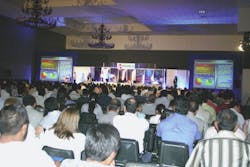9-11 in Merida, Yucatan, Mexico.
The key objective of the event was knowledge exchange of methodologies and technologies in the management, operation and maintenance of pipeline systems. The convention was an important platform for the divulgence of recent technological progress in the transportation of hydrocarbons through pipeline systems, especially involving technologies for developing and gathering real-time information to improve safe operation and environmental preservation. The convention was also a forum for the analysis of new technologies aimed at management of the mechanical integrity and risk in pipeline systems.
The event covered an area of 120,000 square feet and included 150 Mexican and foreign companies, both production and service providers. Exhibitors from outside Mexico came from the United States, the United Kingdom, Austria, Norway, Canada and Peru, among others.
PEMEX owns more than 26,000 miles of transportation pipelines and 12,500 miles of loading and collection pipelines, and the investment in refurbishing and maintaining those assets will amount to $326 million in 2005. PEMEX officials emphasized that 25 percent of the leaks and accidents that happen in the pipeline systems are associated with third-party mistakes, usually construction companies not related to PEMEX that work with heavy construction machinery and damage the pipelines. Of course, corrosion related to pipeline aging also plays an important role. The company expects to invest another $522 million from 2006 through 2008.
Transporting oil by over-the-road trucking costs as much as $6 per barrel, while pipelines reduce the cost to 85 cents per barrel. But there are five key challenges to extending the use of pipelines in Mexico.
Five challenges
First, a major investment is required to expand pipeline systems needed to satisfy new liquefied natural gas regasification plant sites located on the Pacific coast. Then, private investment must be encouraged through the issue of fair regulations and legal assurance for the potential investors. Next would be a transition toward a new directorship scheme of management and control of PEMEX activities, thus leading to a single operation center for pipeline systems with remote monitoring and real-time operation. A legal framework aimed at simplifying and creating a new infrastructure ensuring access to pipelines for refurbishing and maintenance work is the fourth challenge. Finally, defining and creating an integral management function for the pipeline systems aimed at ranking investment projects, executing maintenance programs and conducting an orderly transportation process through the pipeline network will be required.
PEMEX has already implemented a Program for Support of Safety, Health and Environment Protection. This program takes into account that risk reduction in the operation of pipeline systems requires a priority investment that cannot be postponed under any circumstances. For this reason, $30 million will be invested to update the computerized monitoring and supervisory control and data acquisition (SCADA) system across the Mexican country. Also in November, the Mexican Senate unanimously approved a financial package for PEMEX that will provide the company access to $2.2 billion for investing in infrastructure development.
Modesto Vazquez, [email protected], is Executive Editor for “InTech Mexico Automatizacion” and a member of the Editorial Board for “Manufactura” magazine, the largest industrial magazine in Mexico.

